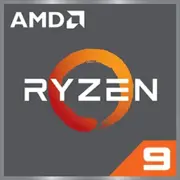AMD Ryzen 9 PRO 6950H

AMD Ryzen 9 PRO 6950H: Power and Efficiency in a Slim Body
March 2025
Laptop processors have long ceased to be a compromise between performance and mobility. A prime example is the AMD Ryzen 9 PRO 6950H, a chip that combines 8 cores, advanced graphics, and energy efficiency. Let’s explore why it has become a popular choice for professionals, gamers, and anyone who values battery life.
1. Architecture and Process Technology: Zen 3+ and RDNA 2 Under the Hood
The codename Rembrandt conceals a hybrid architecture of Zen 3+ (CPU) and RDNA 2 (iGPU). The chip is manufactured using a 6nm TSMC FinFET process, ensuring a balance between transistor density and power consumption.
- Cores and Threads: 8 cores and 16 threads. Base frequency is 3.3 GHz, maximum turbo frequency is 4.9 GHz.
- Cache: 16 MB L3 — enough for quick data processing in demanding applications.
- Integrated Graphics: Radeon 680M with 12 compute units (768 threads) and a frequency of up to 2.4 GHz. This is the most powerful iGPU in AMD's lineup at the time of release.
Architectural Features:
- Zen 3+ is optimized for mobile devices: reduced memory access latency and improved support for DDR5/LPDDR5.
- SmartShift and Smart Access Memory — technologies that redistribute power between the CPU and GPU in real-time, which is critical for gaming and rendering.
2. TDP 45W: Energy Management Without Loss
With a TDP of 45W, the processor is positioned as a solution for high-performance ultrabooks and compact workstations. However, its consumption is flexibly regulated in reality:
- In Eco Mode (settings through laptop software), TDP drops to 35W, reducing heat and noise but somewhat limiting performance.
- In turbo mode, power temporarily reaches 80W, which allows it to handle heavy tasks effectively.
Thermal Package: Even under maximum load, temperatures rarely exceed 95°C, thanks to an efficient cooling system based on soldered thermal paste (in top-end laptops like the Lenovo ThinkPad Z16 Gen 3).
3. Performance: Numbers and Real-World Tasks
Geekbench 6:
- Single-Core: 1777 — comparable to desktop Ryzen 5 5600X.
- Multi-Core: 8366 — close to Intel Core i9-12900H (with 14 cores).
Application Tests:
- Office Work: In Microsoft Office, a browser with 50+ tabs, and simultaneous video rendering in DaVinci Resolve, the processor does not stutter.
- Multimedia: Rendering 4K video in Premiere Pro takes ~8 minutes (compared to ~12 minutes with Ryzen 7 5800H).
- Gaming: In Cyberpunk 2077 on iGPU (1080p, low settings) — 38-45 FPS; with a discrete RTX 4060 (external) — stable 60 FPS at 1440p.
Turbo Mode: In gaming or rendering, the CPU frequency holds steady at 4.5–4.7 GHz for up to 20 minutes, after which it decreases to 4.1 GHz to stabilize temperatures.
4. Use Cases: Who is the Ryzen 9 PRO 6950H Suitable For?
- Professionals: Video editors, programmers, CAD engineers. For example, in Blender, the chip is 18% faster than Core i7-12700H.
- Gamers: Buyers of compact laptops with discrete graphics (e.g., ASUS ROG Flow X13 2025).
- General Users: Those who want long battery life (8+ hours) without compromising speed.
5. Battery Life: How Long Will the Laptop Last?
With a 99 Wh battery (maximum allowed capacity for air travel):
- Web Browsing: Up to 10 hours at 150 nits brightness.
- Video Editing: 3.5–4 hours.
Power Saving Technologies:
- Precision Boost 2 — targeted frequency increase of cores without excess energy consumption.
- Adaptive Power Management — automatic shutdown of unused components.
6. Comparison with Competitors
- Intel Core i7-1360P (28W): Better in single-threaded tasks (Geekbench 6 SC ~1900), but weaker in multi-threaded tasks (MC ~7200). Suitable for ultrabooks but struggles under prolonged loads.
- Apple M3 Pro: 15% faster in video rendering (thanks to macOS optimization), but limited compatibility with Windows applications.
- Previous Generation (Ryzen 9 5900HX): Ryzen 9 PRO 6950H is 22% more energy-efficient at the same performance level.
7. Pros and Cons
Strengths:
- Best-in-class integrated graphics.
- Support for DDR5-4800 and PCIe 4.0.
- Optimization for multitasking.
Weaknesses:
- High price: Laptops with this CPU start at $1500 (e.g., HP EliteBook 865 G9).
- Scarcity of models with 120+ Hz screens — more common in the premium segment.
8. How to Choose a Laptop with Ryzen 9 PRO 6950H?
- Type of Device:
- Ultrabook: Dell XPS 15 (2025) — weight 1.8 kg, 4K OLED display.
- Gaming: ASUS TUF Dash F15 — with RTX 4070, starting price $1700.
- Workstation: Lenovo ThinkPad P1 Gen 6 — with ISV certification for CAD applications.
What to Look For:
- Cooling: At least two fans and heat pipes.
- RAM: 32 GB DDR5 — for handling "heavy" projects.
- Battery: At least 80 Wh for 6+ hours of battery life.
9. Conclusion: Is It Worth Getting?
Ryzen 9 PRO 6950H is the choice for those who need mobility without compromise. This processor is for:
- Designers who want to work on the go.
- Gamers who appreciate compact designs.
- Corporate users who need stability (support for AMD Pro technologies: encryption, remote management).
Key Benefits: Desktop power in a laptop, 8+ hours of battery life, and readiness for any tasks. If your budget is $1500–$2000, this is the optimal choice for 2025.
Basic
CPU Specifications
Memory Specifications
GPU Specifications
Miscellaneous
Benchmarks
Compared to Other CPU
Share in social media
Or Link To Us
<a href="https://cputronic.com/en/cpu/amd-ryzen-9-pro-6950h" target="_blank">AMD Ryzen 9 PRO 6950H</a>